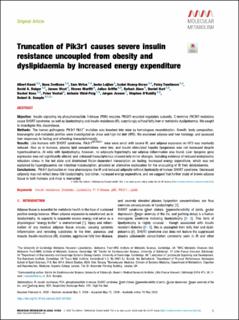Truncation of Pik3r1 causes severe insulin resistance uncoupled from obesity and dyslipidaemia by increased energy expenditure
| dc.contributor.author | Kwok, Albert | |
| dc.contributor.author | Zvetkova, Ilona | |
| dc.contributor.author | Virtue, Samuel | |
| dc.contributor.author | Luijten, Ineke | |
| dc.contributor.author | Huang-Doran, Isabel | |
| dc.contributor.author | Tomlinson, Patsy | |
| dc.contributor.author | Bulger, David A. | |
| dc.contributor.author | West, James | |
| dc.contributor.author | Murfitt, Steven | |
| dc.contributor.author | Griffin, Julian | |
| dc.contributor.author | Alam, Rafeah | |
| dc.contributor.author | Hart, Daniel | |
| dc.contributor.author | Knox, Rachel | |
| dc.contributor.author | Voshol, Peter | |
| dc.contributor.author | Vidal-Puig, Antonio | |
| dc.contributor.author | Jensen, Jørgen | |
| dc.contributor.author | O'Rahilly, Stephen | |
| dc.contributor.author | Semple, Robert K. | |
| dc.date.accessioned | 2021-02-02T08:50:24Z | |
| dc.date.available | 2021-02-02T08:50:24Z | |
| dc.date.created | 2020-08-31T12:36:55Z | |
| dc.date.issued | 2020 | |
| dc.identifier.citation | Molecular Metabolism. 2020, 40(2020), Artikkel 101020. | en_US |
| dc.identifier.issn | 2212-8778 | |
| dc.identifier.uri | https://hdl.handle.net/11250/2725716 | |
| dc.description | This is an open access article under the CC BY license (http://creativecommons.org/licenses/by/4.0/). | en_US |
| dc.description.abstract | Objective: Insulin signalling via phosphoinositide 3-kinase (PI3K) requires PIK3R1-encoded regulatory subunits. C-terminal PIK3R1 mutations cause SHORT syndrome, as well as lipodystrophy and insulin resistance (IR), surprisingly without fatty liver or metabolic dyslipidaemia. We sought to investigate this discordance. Methods: The human pathogenic Pik3r1 Y657∗ mutation was knocked into mice by homologous recombination. Growth, body composition, bioenergetic and metabolic profiles were investigated on chow and high-fat diet (HFD). We examined adipose and liver histology, and assessed liver responses to fasting and refeeding transcriptomically. Results: Like humans with SHORT syndrome, Pik3r1WT/Y657∗ mice were small with severe IR, and adipose expansion on HFD was markedly reduced. Also as in humans, plasma lipid concentrations were low, and insulin-stimulated hepatic lipogenesis was not increased despite hyperinsulinemia. At odds with lipodystrophy, however, no adipocyte hypertrophy nor adipose inflammation was found. Liver lipogenic gene expression was not significantly altered, and unbiased transcriptomics showed only minor changes, including evidence of reduced endoplasmic reticulum stress in the fed state and diminished Rictor-dependent transcription on fasting. Increased energy expenditure, which was not explained by hyperglycaemia nor intestinal malabsorption, provided an alternative explanation for the uncoupling of IR from dyslipidaemia. Conclusions: Pik3r1 dysfunction in mice phenocopies the IR and reduced adiposity without lipotoxicity of human SHORT syndrome. Decreased adiposity may not reflect bona fide lipodystrophy, but rather, increased energy expenditure, and we suggest that further study of brown adipose tissue in both humans and mice is warranted. | en_US |
| dc.language.iso | eng | en_US |
| dc.title | Truncation of Pik3r1 causes severe insulin resistance uncoupled from obesity and dyslipidaemia by increased energy expenditure | en_US |
| dc.type | Peer reviewed | en_US |
| dc.type | Journal article | en_US |
| dc.description.version | publishedVersion | en_US |
| dc.rights.holder | © 2020 The Authors. | en_US |
| dc.source.pagenumber | 12 | en_US |
| dc.source.volume | 40 | en_US |
| dc.source.journal | Molecular Metabolism | en_US |
| dc.identifier.doi | 10.1016/j.molmet.2020.101020 | |
| dc.identifier.cristin | 1826210 | |
| dc.description.localcode | Institutt for fysisk prestasjonsevne / Department of Physical Performance | en_US |
| cristin.ispublished | true | |
| cristin.fulltext | original | |
| cristin.qualitycode | 1 |
Tilhørende fil(er)
Denne innførselen finnes i følgende samling(er)
-
Artikler / Articles [2096]
-
Publikasjoner fra Cristin [1084]
